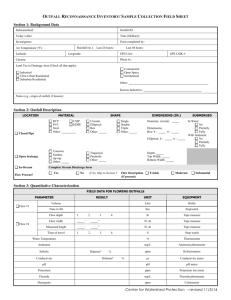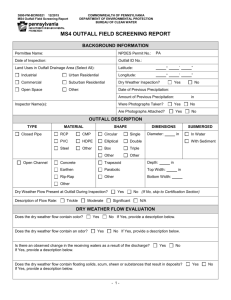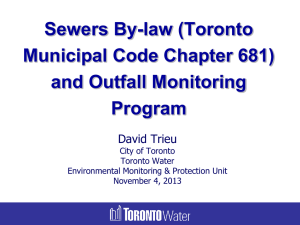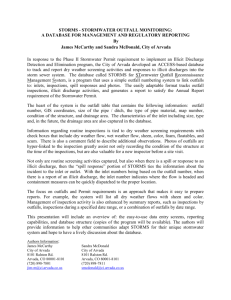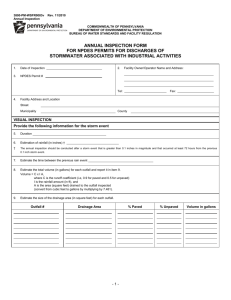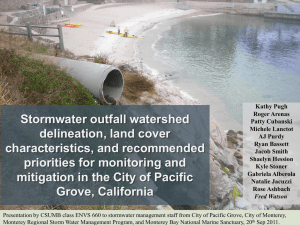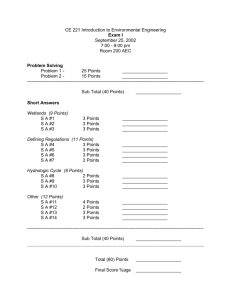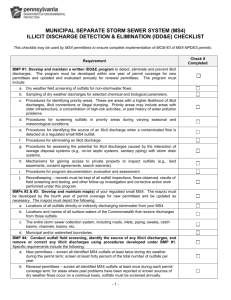3. Procedure for Managing Existing and New Priority Outfalls
advertisement
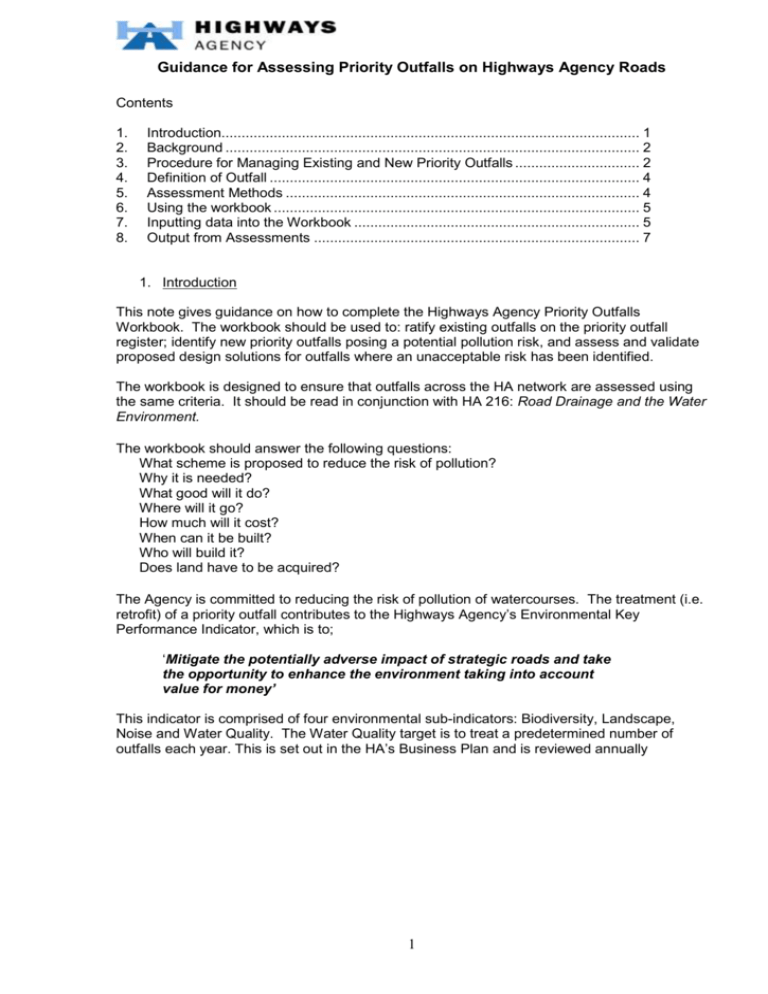
Guidance for Assessing Priority Outfalls on Highways Agency Roads Contents 1. 2. 3. 4. 5. 6. 7. 8. Introduction........................................................................................................ 1 Background ....................................................................................................... 2 Procedure for Managing Existing and New Priority Outfalls ............................... 2 Definition of Outfall ............................................................................................ 4 Assessment Methods ........................................................................................ 4 Using the workbook ........................................................................................... 5 Inputting data into the Workbook ....................................................................... 5 Output from Assessments ................................................................................. 7 1. Introduction This note gives guidance on how to complete the Highways Agency Priority Outfalls Workbook. The workbook should be used to: ratify existing outfalls on the priority outfall register; identify new priority outfalls posing a potential pollution risk, and assess and validate proposed design solutions for outfalls where an unacceptable risk has been identified. The workbook is designed to ensure that outfalls across the HA network are assessed using the same criteria. It should be read in conjunction with HA 216: Road Drainage and the Water Environment. The workbook should answer the following questions: What scheme is proposed to reduce the risk of pollution? Why it is needed? What good will it do? Where will it go? How much will it cost? When can it be built? Who will build it? Does land have to be acquired? The Agency is committed to reducing the risk of pollution of watercourses. The treatment (i.e. retrofit) of a priority outfall contributes to the Highways Agency’s Environmental Key Performance Indicator, which is to; ‘Mitigate the potentially adverse impact of strategic roads and take the opportunity to enhance the environment taking into account value for money’ This indicator is comprised of four environmental sub-indicators: Biodiversity, Landscape, Noise and Water Quality. The Water Quality target is to treat a predetermined number of outfalls each year. This is set out in the HA’s Business Plan and is reviewed annually 1 Guidance for Assessing Priority Outfalls on Highways Agency Roads 2. Background In 2000, the Highways Agency commissioned URS (“Identification of Outfalls Posing a Pollution Risk”, URS for the HA, 2000) to investigate the number of potentially polluting outfalls across the HA network. This desk study identified 271 outfalls that potentially posed a pollution risk to downstream surface watercourses. The outfalls were classified A-E according to their perceived risk. Of these, 58 outfalls were placed in the two highest categories: A and B, with the remainder in categories C to E. (Category E outfalls are those that would have been in one of Categories A to D, but were reported to have existing pollution prevention measures sufficient to exclude them from those higher risk categories.) Between 2002-2003 Managing Agent Contractors were asked to re-investigate the category A and B outfalls to confirm the existing risk assessment and identify a programme of work to treat the outfalls. Local management of the priority outfalls is primarily dealt with by TO and their Managing Agents and the Regional Environmental Advisor (REA). Major Projects can however become involved where a priority outfall can be managed as part of the TPI programme. Technical support is provided by the HA’s Water Quality Advisor on technical details relating to the provision of new outfalls to the programme, the assessment process and appropriate retrofit solutions. 3. Procedure for Managing Existing and New Priority Outfalls The Highways Agency has compiled a register of the 271 outfalls, known as the Priority Outfalls Register. This is used to record the location and risk status of all the outfalls identified by URS in 2000. It will be developed to record when schemes to reduce pollution risk have been implemented, and the effect of such schemes on the assessed risk and category of the outfall. Where new outfalls are identified that appear to pose a risk placing them within categories A to D, these should be added to the register, once HA approval has been obtained. The steps to be adopted by HA Area Teams when prioritising and managing the priority outfalls programme are set out below. Steps: 1 All category A and B outfalls within an Area should already have been reinvestigated and confirmed (or dismissed) as posing a pollution risk. This reinvestigation should have been undertaken between 2002-2003 using the methods detailed in the report “Identification of Outfalls Posing a Pollution Risk”, URS 2000. If this has not been undertaken for a category A or B outfall this should now be done using this guidance note and accompanying workbook. 2 If an outfall is confirmed as posing a risk then Agents should put forward proposals for improvement schemes to the Area Manager and Regional Environmental Advisor (REA). If an outfall is reclassified as a category C or D outfall then the Area Manager and REA must be notified and the Priority Outfalls Register amended accordingly. If an outfall is dismissed then the Area Manager and REA should be notified and the outfall removed from the Priority Outfalls Register; All Category C-E outfalls should be reinvestigated and confirmed (or dismissed) as posing a pollution risk using methods detailed in step 1. If an outfall is re-classified as Category A or B Managing Agents should put forward proposals for improvement schemes to the Area Manager and REA and the Priority Outfalls Register amended accordingly; 2 Guidance for Assessing Priority Outfalls on Highways Agency Roads 3 If an outfall is confirmed as Category C or D, the REA should be notified; If an outfall is dismissed then the Area Manager and REA should be notified and the outfall removed from the Priority Outfalls Register; If a NEW outfall is identified which is not on the priority outfalls register but is believed to pose a pollution risk then the following steps should be undertaken; Assess the outfall/receiving watercourse using the same methods set out in this guidance note and accompanying workbook; Classify the outfall category A-D accordingly; Seek confirmation from the Water Quality Advisor on technical assessment; Notify Area Manager and REA of additional outfall and update Priority Outfall Register accordingly; If the new outfall is a Category A-B outfall then Agents should put forward proposals for improvement schemes to the Area Manager and REA. Where complex and expensive retrofit solutions (costing > £100,000) are proposed for treating priority outfalls, TO should consult the Water Quality Advisor on the appropriateness of the proposals. Tips and Warnings: The following points should be noted: Managing Agents must keep TO and the REA informed of any new priority outfalls that might come to light and are not included on the Priority Outfalls Register. There is currently no list for the treatment of soakaways. It is however acceptable that further investigations can be undertaken on soakaways where they are known to be located within Zone 1 of a Source Protection Zone. This is because of the potential risk associated with contaminating a potable water supply as a result of an accidental spillage. Any such cases should be referred to the HA Area Teams by the Agent and The HA’s Water Quality Advisor’s views sought before proceeding with any course of action Sufficient time should be allowed for the Water Quality Advisor to review detailed technical reports e.g. 2 weeks The Water Quality Advisor should be notified immediately of any significant difficulties arising with the Regulatory Authorities in relation to HA water quality policy 3 Guidance for Assessing Priority Outfalls on Highways Agency Roads 4. Definition of Outfall The term outfall as used in this note and the workbook differs slightly from that defined in HD43 and other HA documents. In HD43 it is used to describe the structure, often a headwall, at which the highway runoff discharges to a receiving watercourse. As this note and workbook are concerned with the effect of runoff on watercourses, a wider definition has been used. Often, where a road crosses a river, there will be more than one such outfall structure discharging runoff, and it will be the cumulative impact of all these discharges which will define the risk of pollution. Similarly for a road running parallel to a river and discharging at several locations. So in this note and workbook, the term outfall has been used to describe the group of outfall structures discharging highway runoff within any one reach of a watercourse. Where no reaches are defined (on minor watercourses), or where the boundary of a reach occurs close to, or even between outfall structures, a judgement must be made, and justified, on how the outfall is defined. 5. Assessment Methods DMRB 11.3.10 (HA 216) has two methods for assessing the risk of pollution from routine runoff at a surface watercourse, one for assessing the risk at a soakaway (not used in the workbook) and one for assessing spillage risk for any outfall. Methods A and B in Annex I of DMRB 11.3.10 assess the risk of pollution from routine runoff at a surface watercourse. Method B need only be used if Method A indicates there may be a high risk. Method A is a simple method of assessing likely impacts and requires three parameters: the AADT of the road traffic, the water quality objective (RE number) and the dilution. The first two are described in 9 and 6 below. The dilution is calculated in the attached spreadsheet. Using the calculated value of dilution and the AADT figure, a point can be plotted on Figure A.2. If the point is below the relevant RE line, the risk from routine runoff may be high and Method B should be used. If the point is above the RE line, the risk will be low and no further assessment for routine runoff will be needed. Method B assesses the possible impact on the routine runoff on the concentration levels of dissolved copper and total zinc in the receiving watercourse. It calculates the build-up rate of these pollutants, based on the drained area of carriageway and the AADT, and determines whether the allowable concentration levels in the receiving watercourse will be exceeded. This method need only be used if Method A shows a possible high risk. Method D determines the risk that a spillage accident will occur within the area of road draining to the outfall, and whether that accident will lead to a pollution incident. 4 Guidance for Assessing Priority Outfalls on Highways Agency Roads 6. Using the workbook The workbook is an excel workbook, with five worksheets. The first one acts as a summary sheet with all the important data for the outfall and the results of the assessments. The second one is the data sheet, where most of the information should be entered. The last three sheets contain the three methods A, B and D for assessing the outfall. Cells where data should be entered are shown white. In some of these a choice of possible entries is given. Green shaded cells indicate where data has been carried forward from another sheet or where the workbook automatically carries out calculations. Brown shaded cells indicate tables given as a reference in completing the worksheets. In many cases engineering judgment will be needed, for example in considering the efficiency of treatment systems. In these cases, the judgment should be justified in the adjacent textbox. These and boxes for comments are shown with double line edging. Worked examples of the workbook are available, working through some of the situations used as worked examples in Annex II of HA 216. 7. Inputting data into the Workbook (numbers in this section relate to those in the Data sheet in the workbook) General 1. Road Number. If the outfall is located at a junction of two HA roads, give both road numbers. 2. HA Area. 3. OSGR. Give the Ordnance Survey Grid Reference for the centre of the main outfall. Use six figure references for both Easting and Northing. 4. Receiving water body. Give the name of the watercourse, if known, and where appropriate, the name of the relevant reach. 5. Other Factors. List any other factors that may affect the sensitivity of the site. For example if a sensitive site (eg. SSSI, SPZ) is affected by the watercourse downstream of the outfall; if there is water abstraction downstream; if there is a history of pollution, if there is significant amenity use or if the regulator considers the site to pose a particular threat. If the road carries an unusually high proportion of hazardous loads (eg to an oil refinery or chemical plant) that should be noted. Where a factor is considered to affect the risk, the ‘existing measures factor’ (see 23 below) may have to be increased by 1.3 for each factor, to a maximum of two factors. In situations where there are no existing pollution reduction measures present, the existing measures factor may be greater than 1. For Method A 6. Water Quality Objective. Give the Rivers Ecosystem Classification number for the water quality objective of the surface watercourse, if known. If it is not available for the watercourse at the outfall, the figure should be given for the first point downstream where a RE number is available. If no RE number is available, use the equivalent GQA letter. (GQA refers to the measured Chemical General Quality Assessment of the watercourse. A GQA of A is equivalent to an objective of RE1.) 7. Low flow of watercourse. This is an important parameter in assessing pollution risk and is defined as the flow exceeded in a watercourse for 95% of the time in an average year. It is called the Q95 flow. The most reliable figures are obtained from gauging stations where flow records have been kept for at least five years. The Hydrometric Register published every five years by CEH Wallingford is a useful reference. However most outfalls are remote from such gauging stations. It may 5 Guidance for Assessing Priority Outfalls on Highways Agency Roads be possible to make an estimate of the low flow by comparing the watercourse with another in a similar catchment, which has a gauging station. For watercourses predominately fed by groundwater, it may be possible to calculate the low flow using the IOH method. For outfalls listed in the URS 2000 report, the low flow in that report may be taken as a first estimate. For ephemeral watercourses, where the low flow figure is zero, a nominal figure of 0.001 m3/sec should be used to give a figure for the dilution. 8. Rainfall depth. Estimate the rainfall depth using Figure A.1 in Annex A of HA 216 9. Traffic Flow. Use the latest available figure for the two-way AADT. Where, exceptionally, only one carriageway drains to the outfall, the AADT for that carriageway only should be used. Where the outfall receives runoff from a junction or minor roads, method D will require details of the AADT of any slip roads or minor roads. Methods A and B should use only the AADT of the major road, unless the area of that road draining to the outfall is less than 25% of the overall area, in which case the AADT of the road with the largest contributing area should be used. 10. Width of carriageway draining to the outfall. Include any hard strips or hard shoulders. Do not include central reserves, grass verges, or surface water channels. 11. Length of carriageway draining to the outfall. 12. Areas of junctions draining to the outfall. To ensure the method includes all the drained areas, it may be necessary to include an estimate of the areas of any junctions or minor roads not already included. 13. Runoff co-efficient. Use 0.5, unless a different figure can be justified by special circumstances such as a steep (>3%) longitudinal gradient on the road when a higher co-efficient may be appropriate. Additional data for Method B (if required) 14. Hardness of water. If this figure is not available from the regulator, consult water hardness maps, held by water companies. If the site is located in a hard water area, a figure exceeding 100 mg/l may be assumed. 15. Upstream dissolved copper. If this figure is not available from the regulator, use half the maximum allowable concentration as given in Table 2.1 appropriate for the hardness and the objective in 6 above. 16. Upstream total zinc. As for 16 above. Additional for Method D 17. %HGV. Use latest available data. 18. Location of Site. The spillage risk will depend on how quickly emergency personnel can reach the site. 19. Junction type. List all junctions on the length of road to be assessed. 20. Type of receiving watercourse. If the discharge is a surface watercourse, use the figure in 6 above. If it discharges to groundwater, this should be noted. 21. Rural or urban. The road should be classified as urban if traffic on an all purpose road is subject to a speed limit of 40 mph or less. 22. Data for other roads. As in 9 to 13 and 17 above as required, for any slip roads or side roads. 6 Guidance for Assessing Priority Outfalls on Highways Agency Roads Other data, if available 23. Any existing pollution prevention measures and measures proposed to reduce the risk of pollution. Methods A and B: Refer to Table 3.2 in HA 103, included in the workbook, which gives indicative factors by which certain combinations of systems have been found to reduce the pollution from routine runoff. If any of these systems is present in the drainage system, a judgment must be made, and justified, on the effect it may have on the pollution risk. This will depend on the size of the system and its design. Where one or more of these systems is proposed to reduce an existing risk, a judgment must be made, and justified, on the residual risk, once the system is installed. Similarly, the impact of any other existing factor (see 5) should be justified. Method D: Refer to Figure 7.1 in HA 216, included in the workbook, which gives indicative factors for the reduction of risk from spillage risk. If any of these systems is already present, a judgment must be made, and justified, on the effect they may have on the pollution risk and a factor should be added in the assessment Method D, and the resultant spillage risk calculated. Where one or more of these systems is proposed to reduce an existing risk, a judgment must be made, and justified, on the risk reduction factor to be used, and this factor should be added in the assessment Method D, and the residual spillage risk calculated. Similarly, the impact of any other existing factor (see 5) and how it is estimated to affect the existing risk should be justified. 8. Output from Assessments The workbook will assess the risks when methods A, B (where needed) and D have been used. It will determine which category the outfall is in (both before and after proposed works), using the URS definition from the 2000 report. The original 2000 category should also be given if known. If the outfall is not in category A to D, the workbook will report the category as X. Costs: The proposed cost of the works should be estimated. The estimate from the PAR submission will be sufficient. Land Requirements: The likely requirements for land acquisition, or licence for construction, or right for future maintenance should be given. Other factors: There may be other factors, which make works at an outfall particularly desirable. These should be listed as appropriate. URS number: This is the number given to the outfall in the 2000 URS report. Table H from URS report is available to MAs. Summary: A brief description should be given of the outfall and why measures are proposed, including the effect these measures will have on the pollution risk. 7
